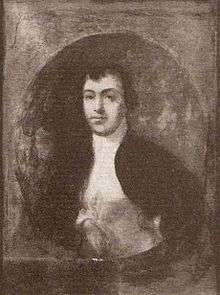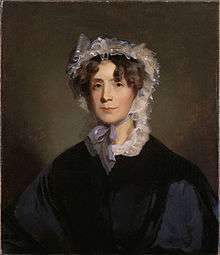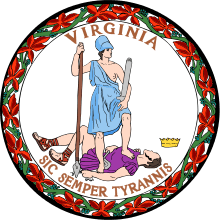Thomas Mann Randolph Jr.
| Thomas Mann Randolph, Jr. | |
|---|---|
 Portrait of Governor Randolph | |
| 21st Governor of Virginia | |
|
In office December 1, 1819 – December 1, 1822 | |
| Preceded by | James Patton Preston |
| Succeeded by | James Pleasants |
| Member of the U.S. House of Representatives from Virginia's 21st district | |
|
In office March 4, 1803 – March 3, 1807 | |
| Preceded by | District created |
| Succeeded by | Wilson C. Nicholas |
| Member of Virginia House of Delegates | |
|
In office 1819-1820 1823-1825 | |
| Member of the Virginia Senate | |
|
In office 1793-1794 | |
| Personal details | |
| Born |
October 1, 1768 Tuckahoe Plantation, Goochland County, Virginia |
| Died |
June 20, 1828 (aged 59) Monticello, Charlottesville Virginia |
| Political party | Democratic-Republican |
| Spouse(s) | Martha Jefferson |
| Children | 12 |
| Parents |
Thomas Mann Randolph, Sr. Anne Cary |
| Alma mater | College of William and Mary, University of Edinburgh |
| Profession | Planter, soldier and politician |
Thomas Mann Randolph Jr. (October 1, 1768 – June 20, 1828) was a planter, soldier, and politician from Virginia. He served as a member of both houses of the Virginia General Assembly, a Representative in the U.S. Congress, and as the 21st Governor of Virginia, from 1819-1822. He married Martha Jefferson, the oldest daughter of Thomas Jefferson, third President of the United States. They had eleven children who survived childhood. As an adult, Randolph developed alcoholism, and he and his wife separated for some time before his death.
Early life and education
Thomas Mann Randolph, Jr. was born on October 1, 1768 at Tuckahoe Plantation in Goochland County, Virginia. Thomas was the first son of Thomas Mann Randolph, Sr. (1741–1793) and Anne Cary Randolph (1745–1789). His siblings included older sister, Mary Randolph (1762–1828), author of The Virginia House-Wife (1824), and younger sister, Virginia Randolph Cary (1786–1852), author of Letters on Female Character (1828).
He was the grandson of Archibald Cary (1721–1787) and the great-grandson of Richard Randolph (c.1691–1749) and William Randolph (1650–1711). The Randolphs were among the First Families of Virginia.[1] Randolph was a lineal descendant of Pocahontas through Richard Randolph.[2]
Randolph received his early education from his mother and private tutors, as was customary in many planter families. He attended the College of William and Mary, in Williamsburg, Virginia, and the University of Edinburgh, Scotland, 1785-1788. Though he did not graduate, he continued to study on his own and became a respected botanist.[3]
At the end of 1790, their widower father Thomas Randolph, Sr., at the age of 50, married Gabriella Harvie, who was seventeen and the daughter of a neighboring planter. They had two children, a daughter who died in infancy, and a son they named Thomas Mann Randolph, as if "erasing his first son from his prior marriage."[4]
Political and military career
Elected office
Randolph served in the Virginia State Senate in 1793 and 1794; and was elected as a Republican to the Eighth and Ninth US Congresses (March 4, 1803 – March 3, 1807). During the War of 1812, he was a colonel of the Twentieth Infantry.
He was elected a member of the Virginia House of Delegates, in 1819, 1820, and 1823–1825. He was elected and served as Governor of Virginia, 1819–1822. He was the first son-in-law of a Virginia Governor to be elected governor in his own right. As governor, he was fairly progressive, supporting canals, education, and more political representation for the ordinary people of the state; he also proposed an emancipation proposal that would have freed Virginia's slaves, but this was defeated.[5] His political career in Virginia ended in 1825, when, running for reelection to the House of Delegates from Albemarle County, Randolph finished third among as many candidates, with only the top two candidates earning election. Randolph's colleague in the previous session, William F. Gordon, received the most votes, while Charlottesville attorney Rice W. Woods finished second, garnering 215 votes to Randolph's 79.[6]
After office
Desperate for work in late 1826, Randolph applied to and obtained employment from Secretary of War James Barbour, a former governor of Virginia, as the federal member of a commission to settle a boundary dispute between Georgia and the territory of Florida.[7] The Georgia government suddenly terminated the survey on April 18, 1827,[8] and though Barbour and President John Quincy Adams considered appointing Randolph as a federal agent to deal with the Creeks,[9] such talk, and Randolph's political career, ended when Randolph virulently criticized the indifferent handling of the boundary expedition by Barbour and Secretary of State Henry Clay in Virginia newspapers.[10]
Sale of Edgehill
Randolph and his wife became estranged toward the end of his life, in part because of the stress created by their tenuous financial situation. After inheriting his father's debts upon his death, Randolph had struggled to provide for his younger siblings in addition to his own growing family. The Virginian economic situation suffered several blows, and by the end of his life Randolph's lands were worth far less than they had been when he inherited them. In 1825, in desperation, the Randolph's had to sell their main property, Edgehill, along with its crops, buildings, animals, and slaves, and even this was not enough money to pay back all the family's creditors. Opposed to slavery on principal, the Randolphs attempted to keep their slaves' families together, but facing the prospect of having to disperse the community that lived on their land, Martha wrote that "The discomfort of slavery I have borne all my life, but it’s sorrows in all their bitterness I had never before conceived.”[11]
The loss of his property was humiliating for Randolph, since in Virginian society at that time men had to own a certain amount of land before being allowed to hold office or even to vote. Randolph, who had always had a temper, became increasingly angry toward his wife's father, his sons, and Martha herself, feeling that they did not do enough to save Edgehill but focused on saving Thomas Jefferson's estate, Monticello, instead. Monticello was also in danger of being sold due to debts and the poor economy, but most members of the family believed that it would provide a better chance for them than would the more heavily encumbered Edgehill property. At times Randolph became irrational, and his angry outbursts caused all his adult children to distance themselves from him. He left Martha and their younger children at Monticello with her father, Thomas Jefferson, and lived alone for several years. After Jefferson's death, Martha Randolph moved with her two youngest children to Boston to gain distance from her husband, and to spend time with her older daughter. Randolph and his wife were reconciled shortly before his death, and he was cared for at Monticello. Randolph died there and was interred in the Jefferson family burial ground.[12]
Personal life

In 1790, Randolph married Martha Washington Jefferson (1772–1836), daughter of Thomas Jefferson (1743–1826) and his wife Martha Wayles Skelton Jefferson (1748–1782). They were parents to twelve children, eleven of whom survived to adulthood:
- Anne Cary Randolph (1791–1826), who married Charles Lewis Bankhead (1788-1833).[13]
- Thomas Jefferson Randolph (1792–1875), who married Jane Hollins Nicholas (1798–1871), daughter of Wilson Cary Nicholas (1761–1820).[14]
- Ellen Wayles Randolph (1794–1795).
- Ellen Wayles Randolph (1796–1876), who was named after deceased older sister. She married Joseph Coolidge (1798–1879).
- Cornelia Jefferson Randolph (1799–1871).
- Virginia Jefferson Randolph (1801–1882), who married Nicholas Philip Trist (1800–1874),[15]
- Mary Jefferson Randolph (1803–1876).
- James Madison Randolph (1806–1834), who was the first child born in the White House.
- Benjamin Franklin Randolph (1808–1871), who married Sarah Champe Carter (1808–1896), daughter of Robert Carter and Mary Coles.[16]
- Meriwether Lewis Randolph (1810–1837), who married Elizabeth Anderson Martin (1815–1871). After Randolph's death, she married Andrew Jackson Donelson (1799–1871), a nephew of President Andrew Jackson.[17]
- Septimia Anne Randolph (1814–1887), who married David Scott Meikleham (1804–1849).[18]
- George Wythe Randolph (1818–1867), who briefly in 1862 was Secretary of War of the Confederate States of America, and who married Mary Elizabeth Adams Pope.[19] They had no children.[20]
Thomas Mann Randolph, Jr. died on June 20, 1828.[21]
References
- ↑ Glenn, Thomas Allen, ed. (1898). "The Randolphs: Randolph Genealogy". Some Colonial Mansions: And Those Who Lived In Them : With Genealogies Of The Various Families Mentioned. 1. Philadelphia, Pennsylvania: Henry T. Coates & Company. pp. 430–459.
- ↑ Page, Richard Channing Moore (1893). "Randolph Family". Genealogy of the Page Family in Virginia (2 ed.). New York: Press of the Publishers Printing Co. pp. 249–272.
- ↑ "Thomas Mann Randolph". monticello.org. Retrieved 13 July 2015.
- ↑ Annette Gordon-Reed, The Hemingses of Monticello: An American Family, New York: W.W. Norton & Co., 2008, p. 427
- ↑ Kierner, Cynthia A. (2012). Martha Jefferson Randolph, Daughter of Monticello: Her Life and Times. Chapel Hill: University of North Carolina Press. p. 182. ISBN 978-0-8078-3552-4.
- ↑ Gaines, William H., Jr. Thomas Mann Randolph: Jefferson's Son-in-Law. Baton Rouge, LA.: Louisiana State University Press, 1966, p. 155.
- ↑ Gaines, Thomas Mann Randolph, pp. 166-67.
- ↑ Gaines, Thomas Mann Randolph, pp. 173, 173n.
- ↑ Gaines, Thomas Mann Randolph, pp. 173-74.
- ↑ Gaines, Thomas Mann Randolph, pp. 175-76.
- ↑ "Martha J. Randolph to Ellen W.R. Coolidge, 2 August 1825". “Jefferson Quotes & Family Letters". Thomas Jefferson Foundation, Inc. Retrieved 21 September 2015.
- ↑ Kierner, Cynthia A. (2012). Martha Jefferson Randolph, Daughter of Monticello: Her Life and Times. Chapel Hill: University of North Carolina Press. pp. 190–205; 215; 228–229. ISBN 978-0-8078-3552-4.
- ↑ "Charles Lewis Bankhead," in The Thomas Jefferson Encyclopedia. Th. Jefferson's Monticello (website), accessed 16 November 2013
- ↑ "Jane Hollins Nicholas Randolph," in The Thomas Jefferson Encyclopedia. Th. Jefferson's Monticello (website), accessed 16 November 2015
- ↑ "Nicholas Philip Trist," in The Thomas Jefferson Encyclopedia. Th. Jefferson's Monticello (website), accessed 16 November 2013
- ↑ "Benjamin Franklin Randolph," in The Thomas Jefferson Encyclopedia. Th. Jefferson's Monticello (website), accessed 16 November 2013
- ↑ "Meriwether Lewis Randolph". www.findagrave.com. Find A Grave Memorial. Retrieved 11 August 2016.
- ↑ "Septimia Ann Randolph Meikleham," in The Thomas Jefferson Encyclopedia. Th. Jefferson's Monticello (website), accessed 16 November 2013
- ↑ "George Wythe Randolph," in The Thomas Jefferson Encyclopedia. Th. Jefferson's Monticello (website), accessed 16 November 2013
- ↑ "Genealogy of the Page Family in Virginia" by Richard Channing Moore Page
- ↑ "Thomas Mann Randolph, Jr". www.findagrave.com. Find A Grave Memorial. Retrieved 11 August 2016.
External links
 Media related to Thomas Mann Randolph, Jr. at Wikimedia Commons
Media related to Thomas Mann Randolph, Jr. at Wikimedia Commons- biographic sketch at U.S. Congress website
- Thomas Mann Randolph Jr. at Find a Grave
- Archival Records
![]() This article incorporates public domain material from the Biographical Directory of the United States Congress website http://bioguide.congress.gov.
This article incorporates public domain material from the Biographical Directory of the United States Congress website http://bioguide.congress.gov.
| United States House of Representatives | ||
|---|---|---|
| Preceded by Thomas M. Randolph, Jr. |
Member of the U.S. House of Representatives from Virginia's 21st congressional district March 4, 1803 – March 3, 1807 |
Succeeded by David S. Garland |
| Political offices | ||
| Preceded by James Patton Preston |
Governor of Virginia 1819–1822 |
Succeeded by James Pleasants |
